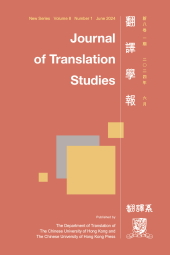 |
|
||||||||||||||||||||||||||||||||||||||||||||||||||||||||||||||||||||||||||||||
| Taiwan’s Road to Bilingualization: A Translation Perspective |
|---|
| Wai-on Law University of St Andrews United Kingdom |
|
Abstract The Taiwanese government has formulated a policy to develop the society to be bilingual (Chinese and English), and all information relevant to foreigners’ lives should be available in English. This descriptive study aims to discuss the feasibility of the policy and make recommendations from the perspectives of institutional translation and translation policy, with special reference to translation quality control. The European Commission is taken as a reference case. In the first part, the documentation method is employed. In the second, the article samples eighteen websites of the central government of Taiwan for bilingualization in checking with the performance indicator set in the Blueprint of the policy as a comparative content analysis. Two bilingual texts from two websites are selected to evaluate the translation quality using genre analysis and the functionalist approach. Given the future volume and scale of government translation, more resources are called for, while the professionalization of the industry and a quality assurance system are recommended. |
| A Brief History of Feng Menglong’s Sanyan in Italian |
|---|
| Antonio Leggieri University of Palermo |
|
Abstract No complete translation of Feng Menglong’s 馮夢龍 (1574–1646) famous trilogy of short stories Sanyan 三言 exists in Italian. However, over the last hundred years, various translators have been attempting to translate excerpts of Feng’s trilogy, with alternating results. This paper analyzes the existing Sanyan stories available in Italian. Firstly, this paper tackles the pioneering period at the beginning of the twentieth century, when Feng’s huaben 話本 were first presented to an Italian audience, albeit in a heavily edited form. The earliest Italian versions of Sanyan stories were mostly rewritings and were heavily influenced by the preexisting foreign versions of the stories they chose to translate. Secondly, after the Second World War, Feng appeared as the author of stories that included anthologies of Chinese literature, again some of which were still translated from other European languages (mostly English and German). Thirdly, the decade of the 1980s was a period when Italian translators, mostly scholars of Chinese literature, decided systematically to translate from the original texts and produced accurate and readable versions, which are still used as references. Fourthly, in the last decade, a new generation of Sinologists has undertaken the study of Sanyan, and their translations are mostly inserted inside of scholarly publications. Finally, this paper shows how the approach to translating Feng has changed over the years, from a quasi-manipulation of the original stories to an extreme respect for the source material. At the same time, the need for a complete version of Sanyan in Italian is called into question at the end of the paper. |
| The Translation and Critical Reception of Nathaniel Hawthorne’s Children’s Literature in Republican China (1912–1949) |
|---|
| Jie Hu Southwest University of Science and Technology Mainland China |
|
Abstract It is generally agreed that the translation of children’s literature is an under-researched area. With only three books focusing on the subject, even rarer is the research on children’s literature in China, and none of which dwells on the translation of American children’s literature in modern China, not to mention the research on the translation of Nathaniel Hawthorne’s children’s literature. Yet Hawthorne’s children’s literature enjoyed a wide circulation in Republican China (1912–1949), which even overshadowed the translation of his often-quoted classics. Based on André Lefevere’s rewriting theory, this article argues that the translation of Hawthorne’s children’s literature was initiated in late Qing when the dominant culture changed its view of children and the importance of children’s education. But it also benefited from ideological advocacy for child-orientation and from the poetic urgency for the establishment of children’s literature in China. The translation, supported by various forms of patronage, ushered in a period of prosperity in the May Fourth era and greatly affected the creation of children’s literature in China as an independent category. Then, confronted with the nationwide political agenda of the impending war, the translation of Hawthorne’s children’s literature lost its impetus beginning in the late 1930s, although there were some translations or retranslations of Hawthorne’s famous fairy tales sporadically in the 1940s. |



